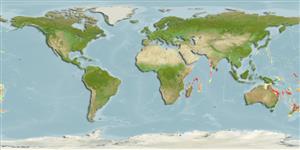Common names from other countries
Classification / Names / Names
Nomes comuns | Sinônimos | Catalog of Fishes (gen., sp.) | ITIS | CoL | WoRMS
Environment: milieu / climate zone / depth range / distribution range
Ecologia
; intervalo de profundidade 33 - 550 m (Ref. 8366). Subtropical
Southern Atlantic to Indo-Pacific: South Africa to New Zealand and throughout Southern Ocean.
Length at first maturity / Tamanho / Peso / Idade
Maturity: Lm ? range ? - ? cm Max length : 3.8 cm TL macho/indeterminado; (Ref. 8366); 5.8 cm TL (female); common length : 2.4 cm TL macho/indeterminado; (Ref. 8366); common length :3.78 cm TL (female)
Minimum depth from Ref. 3113.
Life cycle and mating behavior
Maturidade | Reprodução | Desova | Ovos | Fecundidade | Larvas
Members of the order Isopoda are mostly gonochoric. Mating behavior: Mating usually occurs before and sometimes during the parturial molt. Sperm transfer is indirect. Life cycle: Eggs are brooded in the marsupium, which later hatch into manca postlarva before developing into adults.
Schotte, M., B.F. Kensley and S. Shilling. 1995. (Ref. 3113)
Status na Lista Vermelha da IUCN (Ref. 130435)
Status no CITES (Ref. 108899)
Not Evaluated
Not Evaluated
Uso pelos humanos
| FishSource |
Ferramentas
Mais informação
Nomes comunsSinônimosPredadoresReproduçãoMaturidadeDesovaFecundidadeOvosDesenvolvimento dos ovos
Idade/Tamanho
Crescimento
Comprimento-peso
Comprimento-comprimento
Morfologia
Larvas
Abundância
Fontes da internet
Estimates based on models
Preferred temperature
(Ref.
115969): 12.6 - 23.4, mean 18.8 (based on 99 cells).
Vulnerabilidade
Low vulnerability (10 of 100).
